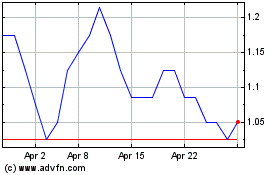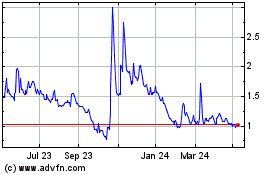Quantum Blockchain Technologies Plc Bitcoin Mining R&D Update
March 11 2022 - 2:00AM
UK Regulatory
TIDMQBT
11 March 2022
Quantum Blockchain Technologies Plc
("QBT" or "the Company")
Bitcoin Mining Research and Development Update
The board of Quantum Blockchain Technologies (AIM: QBT) is pleased to update
shareholders on the current progress of its Bitcoin mining R&D activities.
The Company's multi-technology approach to develop the fastest Bitcoin ("BTC")
miner in the market, is moving rapidly ahead. The board and its R&D Team are
extremely pleased with the results achieved to date and the Company intends to
put them into practical use as soon as possible. In the meantime, QBT is
securing its Intellectual Property ("IP") assets, by filing a number of new
patent applications for each new research result obtained.
Quantum Mining
The Quantum Computing R&D Team has now developed a quantum version of a BTC
mining algorithm, based on Quantum Bit ("qubit") based quantum computation,
using quantum logic gates. Testing of the quantum programme will begin shortly
on a quantum computer, following the signing last week of an NDA with a major
US technology manufacturer.
The new qubit based algorithm is significant enough to encourage the Company to
file a patent application to protect this BTC mining development, which will be
lodged shortly.
Following six months of testing on the D-Wave quantum computer, which is based
on adiabatic quantum annealing computation ("quantum annealing") (i.e., not
using qubits / quantum logic gates), the Company completed the analysis phase
in December 2021, acquiring all of the necessary information. Testing has been
suspended on this type of quantum computer. Most of the work conducted for
programming the adiabatic quantum annealing based computer, has been, however,
very relevant for the Quantum Computing R&D Team, and has resulted in an
innovative reformulation of SHA-256 (the core BTC mining algorithm) as an
optimisation problem.
This new reformulation to be solved with a quantum annealing approach, has now
been developed and tested on a cloud accessed quantum annealing software
simulator, made available to the Company's Quantum Computing R&D Team by a
major Japanese producer. A version of the quantum annealing simulator has been
implemented, using available specifications which will be run initially from an
IT R&D platform in a datacentre in Milan, Italy. This will allow the Company to
develop quantum annealing optimisation simulator code on a number of dedicated
FPGA chips.
The combined use of the quantum optimisation algorithm and the ASIC miner,
which is currently under development by the Company, is expected to increase
the hashing speed, compared to the best ASIC miners announced by competitors.
Tests are ongoing to confirm these initial experimental indications.
A patent application relating to the optimisation conversion of the BTC mining
algorithm and its integration with an ASIC based miner, will be filed as soon
as practical.
Artificial Intelligence based Bitcoin Mining
The Company is pleased to announce that it has appointed an international
expert in the field of Machine Learning to its AI Research Team. The expert is
the former head of the Neural Networks Research Laboratory of the Department of
Computer Science of the University of Milan.
The use of AI techniques (mainly Machine Learning) to speed up the successful
mining of BTC, has been studied by the R&D Team. As part of the testing
process, these techniques have been partially applied across different levels
of the entire BTC mining process. As soon as quantitative results are available
the Company will build prototype "solo" BTC miners (i.e., not in pool mining),
using existing or separate Computer Processing Units ("CPU"), Graphics
Processing Units ("GPU") and FPGA cores.
A patent application on the specific AI techniques developed, will be filed as
soon as practical.
ASIC Development and Second Patent
Drafting of the technical document for the Company's second patent application
is now complete and implementation on an FPGA is nearly finished. Results of
the overall performance achieved by the combination of the optimisations from
the first and the second patent will be obtained for the final FPGA code
shortly. The Company plans to conduct tests using the new optimisations within
an ASIC development environment, to provide more accurate measurements with
respect to energy consumption and mining speed, on a 5nm ASIC, which is the
Company's ultimate goal.
The Company is working with two independent partners to conduct verification
tests on the final performance of QBT's prototype ASIC. Their role is also to
advise on how best to achieve efficiencies in coding, in order to best exploit
the specific manufacturing technologies of individual silicon fabricators, when
it comes to manufacturing of the prototype chips.
Quantitative performance data will be available within a few weeks.
IT infrastructure
The Company's IT infrastructure is now fully operational. Solo mining
activities, created to test AI accelerated miners, running on CPU, GPU and FPGA
are currently being finalised. The Company will provide the results of these
tests once testing has been completed.
Francesco Gardin, CEO and Executive Chairman of QBT, commented: "We have made
impressive progress on all our core R&D areas, and we will now start field
testing our optimisations of BTC mining in the next few weeks.
"We are also conducting internal and independent performance measures to help
us assess mining speed and energy consumption within the ASIC line of research,
which is now at the simulation stage. Based on data we have recorded to date,
we expect to see a higher performance than originally estimated; this is mainly
due to the optimisations which will be included in the second patent
application, based on the work of our cryptography expert and the coding
techniques implemented by our FPGA/ASIC Design Team.
"All of the results will be verified before any cooling techniques are
implemented which, if applied, could allow for a further increase in speed."
This announcement contains inside information for the purposes of Article 7 of
the Market Abuse Regulation (EU) 596/2014 as it forms part of UK domestic law
by virtue of the European Union (Withdrawal) Act 2018 ("MAR"), and is disclosed
in accordance with the Company's obligations under Article 17 of MAR.
For further information please contact:
Quantum Blockchain Technologies Plc
Francesco Gardin, CEO and Executive
Chairman +39 335 296573
SP Angel Corporate Finance (Nominated Adviser & Broker)
Jeff Keating
+44
(0)20 3470 0470
Leander (Financial PR)
Christian
Taylor-Wilkinson
+44 (0) 7795 168 157
About Quantum Blockchain Technologies Plc
QBT (AIM: QBT) is an AIM listed investment company which has recently realigned
its strategic focus to technology related investments, with special regard to
Quantum computing, Blockchain, Cryptocurrencies and AI sectors. The Company has
commenced an aggressive R&D and investment programme in the dynamic world of
Blockchain Technology, which includes cryptocurrency mining and other advanced
blockchain applications.
Glossary of Terms:
ASIC: An Application-Specific Integrated Circuit is an integrated circuit chip
customized for a particular use, rather than intended for general-purpose use.
ASIC chips are typically fabricated using metal-oxide-semiconductor (MOS)
technology, as MOS integrated circuit chips
CPU: The central processing unit (CPU) is the unit which performs most of the
processing inside a computer. It processes all instructions received by
software running on the PC and by other hardware components and acts as a
powerful calculator.
FPGA: A field-programmable gate array is an integrated circuit designed to be
configured by a customer or a designer after manufacturing - hence the term
"field-programmable". The FPGA configuration is generally specified using a
hardware description language (HDL), similar to that used for an
application-specific integrated circuit (ASIC).
GPU: A graphics processing unit (GPU) is a computer chip that renders graphics
and images by performing rapid mathematical calculations.
Nanometer: A nanometer is a unit of measurement that is equivalent to one
billionth of a meter. It is widely used as a scale for building tiny, complex,
and atomic-scale computing and electronic components, such as ASIC chips.
Pool Mining: As part of bitcoin mining, mining "pools" are a network of miners
that work together to mine a block, then split the block reward among the pool
miners. Mining pools are a good way for miners to combine their resources to
increase the probability of mining a block, and also contribute to the overall
health and decentralization of the bitcoin network.
SHA-256: Secure Hashing Algorithm (SHA)-256 is the hash function and mining
algorithm of the Bitcoin protocol, referring to the cryptographic hash function
that outputs a 256 bits long value.
Quantum Annealing (QA): which also includes adiabatic quantum computation, is
a quantum computing method used to find the optimal solution of problems
involving a large number of solutions, by taking advantage of properties
specific to quantum physics like quantum tunnelling, entanglement and
superposition.
Quantum Logic Gates: Is a rudimentary quantum circuit operating on a small
number of qubits. They are the analogues for quantum computers to classical
logic gates for conventional digital computers. Quantum logic gates are
reversible, unlike many classical logic gates.
Qubit: A classical bit can be in two states, it can be either zero or it can be
one. A quantum bit or qubit, however, can be in a sort of zero state and in a
one state at the same time. This situation is called a superposition of
(quantum) states. Qubits have some very particular properties: for instance, it
is not possible to make copies of qubits.
END
(END) Dow Jones Newswires
March 11, 2022 02:00 ET (07:00 GMT)
Quantum Blockchain Techn... (LSE:QBT)
Historical Stock Chart
From Mar 2024 to Apr 2024

Quantum Blockchain Techn... (LSE:QBT)
Historical Stock Chart
From Apr 2023 to Apr 2024
